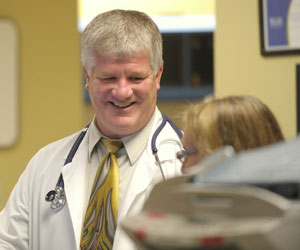In a major announcement last week, the CDC is streamlining existing COVID guidance to reduce the impact of the virus on schools, employment, and the health system. There is better understanding of how to protect people from being exposed to the virus, like wearing masks, testing, and improved ventilation. The announcement recognized that the United States is in a stronger place today with tools like vaccination, boosters, and treatments to protect individuals from severe COVID illness. This provides a baseline of protection for our nation and visitors.
U.S. data on hospitalization and wastewater surveillance suggest that the latest COVID surge is on the downslope, after months of high transmission fueled by Omicron and sub-variants like BA.5. The recent average of newly hospitalized COVID patients is decreasing to about 6,000 people a day, and average deaths are hovering around 400 people a day. In the words of the CDC: “This acknowledges that the pandemic is not over, but also helps us move to a point where COVID-19 no longer severely disrupts our daily lives.”
Here are some of the recommendations that relate to fire and emergency medical services.
As the virus continues to circulate in our communities, efforts will be focused protecting people at high risk of severe illness.
The CDC recommends that individuals assess the risks of spread in the community and continue to exercise caution in settings such as crowded indoor spaces. The guidelines place less emphasis overall on physical distancing as a key measure to avoid exposure. The six-foot standard for social distancing is no longer an explicit recommendation. The CDC suggests that masks should be worn in indoor public settings and on public transportation when the community is at high levels of transmission.
People exposed to someone infected with the coronavirus, vaccinated, or not, no longer need to quarantine. The new guidance says people exposed to COVID should wear a high-quality mask for 10 days and get tested on day five. If the exposed person is still concerned about having the disease, a repeat test done at least 48 hours later provides further reassurance that the individual is not infected.
For people that have tested positive for COVID, with or without symptoms, the isolation guidance remains the same: Isolate for at least five days at home and wear a high quality-mask around other people. Isolation may be ended after five days if the person is fever-free for 24 hours without medication and symptoms are improving, though a mask should be worn through day 10. Immunocompromised people and those who had more severe illness should isolate through day 10.
The CDC no longer recommends routine screening of people without symptoms in most community settings, including schools, businesses, and fire EMS stations. Screening might still be beneficial in high-risk places including long-term care and correctional facilities.
There are continued recommendations regarding staying up to date with vaccination to protect from severe COVID illness, hospitalization, and death. As of June, COVID-related hospitalizations were almost five times higher among unvaccinated adults as compared to those who have gotten jabbed. This guidance will continue into the autumn, when it is likely that Omicron-targeted vaccines will be available, and a campaign to get boosted will occur.
Further updates for health care settings will be coming in the next few weeks.
Fire Chiefs and others will need to continue to evaluate local risks to protect their members, and the public they serve.; Universal protection and use of PPE in the patient care setting will likely remain a necessity when COVID and other infectious illnesses are still circulating.

Dr. James Augustine, MD, FACEP, is Chair of the IAFC COVID-19 Taskforce. He chairs the USACS National Clinical Governance Board. He is a board certified diplomate of the American Board of Emergency Medicine, and a fellow in the American College of Emergency Physicians (ACEP).
View Guidance Summary